FAQs
Scooters Australia


Book a Test Drive
Book a test drive and our team of experts will bring a range of scooters to you!
There are a wide range of ‘scooter’ products on the market today – kids’ scooters, motor scooters, snow scooters and even marine scooters. But what is a mobility scooter?
A mobility scooter is different from these other types of scooters as its purpose is to be a mobility aid for elderly and/or disabled people.
Just like cars, electric scooters vary in price depending on their size, specs and condition. Generally speaking, they can be priced as low as $1400 and range up to $8000, with most people spending between $3000-$6000.
If you’re considering purchasing a mobility scooter, you may be wondering how much it will end up costing you in the long run. Just like a car or any other vehicle, there are ongoing costs beyond the initial purchase of the device.
In this article, we break down how much mobility scooters cost to run, so that you can get a good idea about how to factor this ongoing spending into your budget.
To make things easier, we’ve come up with this simple chart that compares the cost of running a scooter vs the cost of running a car:
Scooter vs Car (costs per year, @ 100kms per week)
- Registration: $500 (Car) v Nil (Scooter)
- Insurance: $1000-$1500 (Car) v $100-$200 (Scooter)
- Fuel: $500-$600 (Car) v $50-$60 (Scooter)
- Servicing: $300-500 (Car) v $100 (Scooter)*
- Depreciation (over 5 yrs): $2000 (Car) v $600 (Scooter)
- Batteries: $50 (Car) v $200-500 (Scooter, depending on the scooter. Li-ion higher)
* Not including call out fee. Basic service only. These are costs per year.
That depends on the scooter you purchase. Large scooters with powerful motors can tackle almost any hill. But it’s always important to take into account the size of the wheels, the weight of the user, and the kind of requirements you have: Do you need a good turning circle so you can take it on public transport? Do you live in a hilly area? Do you want to take it on a plane overseas or go on a cruise? How far do you want to travel on a charge? When we talk to you about your requirements we go through a checklist to make sure we show you the right scooters that fit your needs and that gives you the best chance of finding something that suits you.
Some things you should not do with your scooter:
- Drive through puddles or flooded areas.
- Try to go up steep slopes beyond the recommended grade.
- Drive off gutters or similar heights
- Drive up slopes at an angle rather than head on
- Hill start without leaning forward
If you’re considering using a mobility scooter for the first time, it’s only natural to wonder how safe the device really is. Can using a big, heavy piece of machinery really be a safe choice?
The short answer is yes – mobility scooters have been designed and developed at the highest standards to make sure they’re incredibly safe to use. In fact, if you compare the accident rates of electric scooters with vehicles, or even pedestrians, scooters come out way on top in the safety stakes.
There are, however, a few things that anyone using a mobility scooter needs to be aware of for the wellbeing of both yourself and those around you.
Recent fires in eScooter batteries has raised the question about mobility scooter batteries. Li-ion batteries used in the Luggie scooters have a Battery Management System (BMS) designed to protect the batteries as the are charged and discharged. The battery pack (with the BMS) has been tested and approved by TUV (Europe) to standards EN62133 CE, and UN38.3. This means they are safe for charging using the correct charger and able to be transported by IATA airlines. But beware: ALWAYS USE THE APPROVED CHARGER and do not use an unauthorised repairer to repair or replace both the battery pack and the charger.
In general, as long as 2 years if looked after – Li-ion batteries a lot longer. It all depends on use and care. The scooter should be charged once a week if not being used. Mobility scooter batteries cannot be overcharged as the charger cuts out automatically. It usually takes about 8 hours to recharge if the meter is low. Batteries are maintenance free: they can be tipped over, etc without spilling and they don’t need to be topped up with water. In general, the life of a deep cycle battery is determined by its quality and by how many cycles it has been through – usually in the vicinity of 200-300 cycles if discharged fully, but more cycles if it is only partially discharged. If the battery is discharged by only 20% and then recharged, it will last longer than one that is discharged by 60% and recharged – i.e. it will have more cycles. Batteries also last longer if they are stored in a charged state, not a discharged state.
So it is best if your scooter is charged every night after use. Leaving a battery in a discharged state damages the battery. It is also better to leave the charger “ON” at all times if the scooter is not in use. Batteries reach their peak performance after about 20 cycles.
Warning: Do not use a general purpose charger as this will damage the batteries. Scooter chargers have a three stage charging cycle for cyclic batteries, but car chargers do not. Li-ion batteries must have their own dedicated charger.
This depends on the size of the batteries (measured in amp/hours), the weight of the user, and the steepness of the terrain. The bigger the batteries the further the range. However, a mid sized scooter with standard batteries (around 35 amp hours) will normally go around 25 kms between charges with a 75kg payload on gentle terrain. Larger batteries will give the scooter a range of up to 45 kms. Don’t be fooled by claims outside these figures. Mobility scooter batteries reach their peak performance after about 20 cycles of charge and discharge. Please consult the notes about battery performance in the Specifications page for more information.
All states vary in their regulations for mobility scooter registration. No motor car license is required anywhere, but the Queensland government requires a form of (free) registration. Please check with your state roads authority. The road rules for a scooter are the same as for a pedestrian.
The more powerful scooters will climb a 1:4 slope with an 80kg payload – even more with certain models (some Merits, Afikim and Monarch). Compact scooters will not climb even gentle slopes with more than 60kg payload. What really counts here is the size of the electronic controller rather than the motor or batteries. The same motor using different controllers can have vastly differing performance characteristics, a little like a car with a turbo will outperform a similar size motor.
In general, a mid size scooter with an average payload (say around 75kg) will be able to climb a 1:5 slope. To give you an idea, the public standard for such things as ramps over a railway line, or up to a public building is a 1:14 slope. This means that only when the steepest driveways have to be traversed, or the user is above 100kgs, does an extra powerful scooter need to be specified.
Carrying Capacities are quoted for flat ground only. To give you an idea of what to expect when hills are involved, here’s an example of a scooter with a quoted payload of 220 kgs, at select gradients:
Flat Ground | 9°Gradient | 12°Gradient | 15°Gradient |
Payload | Less 10% | Less 40% | Less 60% |
220 kg | 200 kg | 135 kg | 90 kg |
Use this same formula for all slopes.
WARNING: Small scooters. Irrespective of the manufacturer’s published carrying capacity, using small scooters in steeper areas will damage the motor, especially if the person is over 100 kg. Small scooters are designed for flat and gently sloping areas with less than 1:14 slopes for those under 80kg. If a small scooter is used with too much strain on the motor it may damage the motor and void the warranty.
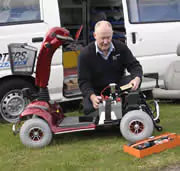 All manufacturers recommend 12 monthly services. A basic service takes about 1-2 hours. Services can be done at the client’s home or at the workshop. Scooters Australia offers home servicing facilities in all capital cities and in many regional centres throughout Australia using our mobile workshop vans. We also repair all makes of mobility scooter as long as the parts are still available, even when it is not one of our brands. Our technicians are trained in both electronics and mechanics.
All manufacturers recommend 12 monthly services. A basic service takes about 1-2 hours. Services can be done at the client’s home or at the workshop. Scooters Australia offers home servicing facilities in all capital cities and in many regional centres throughout Australia using our mobile workshop vans. We also repair all makes of mobility scooter as long as the parts are still available, even when it is not one of our brands. Our technicians are trained in both electronics and mechanics.
Scooters that are used heavily, like golf scooters or carrying heavier payloads or in steep hilly areas, should be given a major overhaul every 3 – 4 years.
Pictured is one of our technicians performing an on-site service. Regular servicing is the best way to protect your scooter and your warranty, and guards against inconvenient breakdown.
WARNING: Servicing your scooter every 12 months helps prevent serious accidents and protects your warranty. It can also save you large sums of money. CLICK HERE for a very sobering story on what might happen if you don’t get your scooter serviced.
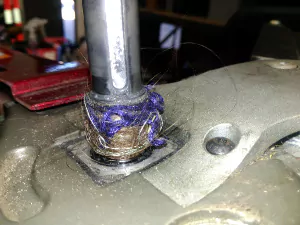
Take a look at this axle (right) and you can see why mobility scooters need regular servicing by an authorised technician.
Note: Scooters purchased over the internet will not be serviced by any of our stores unless the scooter is purchased from Scooters Australia and has a valid serial number listed on our data base. This applies particularly to Luggie scooters.
Punctures seldom occur. But if they do, they can be fixed by local garage, most road services (eg NRMA, RACQ, RACV, etc) or by a Scooters Australia service person. Some models come with solid foam filled tyres, thus eliminating the problem. However, the ride is a bit rougher. Tyres and tubes can be purchased from Scooters Australia on-line HERE.
In general terms there is little difference between three or four wheel mobility scooters in terms of stability. Generally width and low centre of gravity are the most important factors for any scooter. Three wheel scooters are more manoeuvrable in a tight situation and have more leg room, but a four wheel scooter is marginally more stable in rougher terrain or where there are tight corners on a slope. If a person has had experience in riding a bicycle in their youth, a three wheeler will probably be more useful due to its versatility. However, if a person is not confident with driving or balance, then a four wheel scooter would be more suitable because of its better stability.
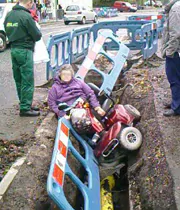 There’s also the compromise Hybrid scooter which has a double front wheel axle (see Medium Size Scooters page).
There’s also the compromise Hybrid scooter which has a double front wheel axle (see Medium Size Scooters page).
Scooters are inherrantly safe and easy to drive – they have to be, as they must pass stingent safety requirements for the European market. But just make sure your scooter is approved by the TGA in Australia. There are scooters on the market that have not passed all the requirements.
However, it doesn’t matter whether you use a three or four wheel scooter, if you try to jump objects like this ditch (pictured left), you’ll inevitably come to grief! Like all things, common sense is the best policy.
We’ve imported a few sample auto fold scooters to test and found them wanting. Some customers like the idea, but many find there are drawbacks after they’ve purchased them. Here’s our assessment.
Manual folding:
Pros:
- Lighter
- Faster fold (see video here)
- The Luggie can be folded in half, so lifting into the car is easier for one person. See videos here and here
- Batteries accessible before folding (they need to be removed for taking on planes).
Cons:
- Normally need to bend down to fold
- Some effort / strength may be needed to fold some scooters
Auto folding:
Pros:
- No need to bend down to fold.
- No effort needed to fold
Cons:
- Heavier: there’s an extra motor (and possibly battery) to lift
- Slower fold
- Battery must stay in scooter to operate the fold (some autos can be folded manually after the battery is removed, but folding is usually more involved – and you still have to manually fold)
- Can’t half fold, so loading by one person is more difficult
- More things can go wrong, with higher maintenance costs: two motors, extra electronics and wiring, and heavier frame.
Compare these images. The auto fold is the one on the left with arrows to the additional motor and electronics (and wiring), with the Luggie on the right.
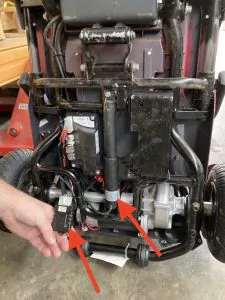
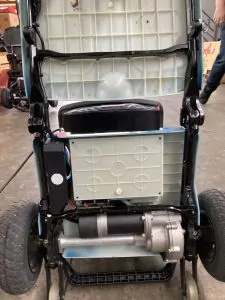
Pull-aparts v Folding
It all comes down to how much you can lift. The heaviest part of a pull apart scooter is usually around 13kgs. A folding scooter can weigh as much as 30kgs, especially if it’s an auto fold scooter. However, the Luggie can also be half folded and levered into the boot and then you only need to be able lift around 14-15 kgs, depending on the model. Here are some pros and cons to consider:
PULL APARTS:
Pros
- Heaviest part less than 15 kgs
- Pieces can be arranged in the boot to suit the space
- Good range with SLA batteries
Cons
- Takes time and effort to pull apart 5 different pieces.
- Seat needs lifting off and is cumbersome and heavy
- Difficult to transport on aeroplanes
- SLA batteries more difficult to transport and have a shorter life
FOLDUPS:
Pros
- Easy to fold in one piece in seconds
- Takes up less storage space
- Li-ion batts easy to transport on planes
- Luggies can be half folded and levered into the boot
Cons
- Less range than SLA batteries
- Heavier to lift if fully folded
Unfortunately there is more than one way to rate the power of a motor. And there is also the issue of the output of the electronics with which the scooter is fitted, and the number of brushes in the motor (a bit like the number of cylinders on a car). The bigger the amp rating of the electronics, the more curent is sent to the motor. Two scooters with the same motors will perform differently with different electronics. So this makes competing claims difficult to assess. Additionally, a four pole motor will deliver more pulling power than a two pole motor. But in the end, the best way is to test drive a scooter to see if it does the job you want it to.
At Scooters Australia you can TRY BEFORE YOU BUY.
All Scooters Australia outlets offer a free no obligation home demonstration on selected models to find the most suitable scooter for your needs*. When you talk to one of our staff they will ask you for some personal details and the kind of use you want from your scooter and will then choose 3 or 4 scooters to show you, in your own home location.
That way you can get the feel for whether a mobility scooter is suitable for you. It’s a totally free service because we believe that you should always try before you buy. But if you want to come to one of our showrooms to try out a selection, that’s OK too. Just give us a call on the 1300 number and you will connect to your nearest store.
*Not available on portable scooters in the small scooter range.
Scooters Australia provides a comprehensive training course once you have purchased a scooter from one of our stores.
We go through the basics of electric scooter controls, use, care, and provide full safety training with a certificate of competency at the conclusion. We do this training at the time of delivery to ensure that you are familiar with the access and safety issues in your neighbourhood.
In most situations, delivery of mobility scooters will be cost free in metropolitan areas and major regional centres. On rare occasions where the location is remote, there may be a delivery charge, open to negotiation with the store manager. Depending on location, there may be a small cost for delivery of liftchairs. Most home health equipment will be delivered by courier at a negotiated cost.
Yes, most Scooters Australia stores can help to arrange comprehensive insurance for your mobility scooter through Blue Badge Insurance Australia.
To find out more, visit www.bluebadgeinsurance.com.au
And as for finance, Scooters Australia have an arrangement whereby a No Interest Ever scheme can put you in a new mobility scooter even if you are on the age pension.
Manufacturers offer from 1 to 3 year’s warranty. This covers all parts and labour (including the electronics), but only if the scooter is delivered to the workshop. If a call-out is required to either repair the scooter or bring it back to the workshop, a call-out fee is charged after the first 30 days. Naturally this warranty does not cover misuse or normal wear and tear, and is limited if the customer has not had the product serviced by an authorised repairer. Some companies promise a three year warranty but they exclude the expensive bits: motors and electronics. So read the warranty carefully. Please consult the warranty documents at the end of the Owner’s Manual for more details. Scooters Australia warranty conforms with the Competition and Consumer Regulations 2010. See our standard warranty here.
Warranty may not cover the scooter if it has not been properly service, like the motor (pictured) that has been burnt out through lack of proper maintenance.
Electric footpath scooters (sometimes called Gophers, buggies or motorised scooters in Australia) are powered by batteries. They are a simple vehicle with few working parts, requiring a relatively low level of maintenance. Mobility scooters come in three or four wheel versions and are primarily designed for use on footpaths or the golf course.
In general, electric scooters have a maximum speed of less than 10 kph (the most common maximum speed allowed by Sate government regulations for a mobility scooter). They are activated by a simple throttle, operated by the fingers, which controls both speed and braking. Steering is via a variety of types of handlebars that operate in a similar fashion to push bikes or motor bikes. They come with varying equipment levels, from twin headlights, blinkers, “bull bars”, even independent suspension, down to basic machines with simple controls.
Quality Control. While we make every effort to ensure that your scooter is free from any manufacturing faults, occasionally something does slip through, just like it does for every manufacturer. However, we do make a thorough assessment of any new product that we plan to import and our technicians check everything they can prior to approving our products for sale. We have been in the mobility scooter busines since 1992 and the original founders still own the company are are intimately involved in making sure that our products are of the highest quality. You can see an example of this in the video where we are checking a washer on the rear axle.
WARNING: Make sure that you have your scooter or powerchair serviced regularly, and to read the Owner’s Manual thoroughly before you use it. Here is a sobering story of someone who did not do this.
Batteries
All modern motorised scooters are powered by 2 x 12 volt batteries. These can be either wet or dry cell batteries, but few scooters these days use wet cell batteries.
Batteries in mobility scooters are not like car batteries in that they are a deep cycle battery. These batteries are rated in Amp Hours – ie how many hours a battery will run when one amp is drawn in power. This rating will determine (along with the efficiency of the motor) the range an electric mobility scooter will travel between charges. The higher the rating, the longer the scooter will run, given similar conditions. Hills and weight load, as well as the surface and the age of the batteries will have an effect on range.
Dry cell batteries come in three basic types: Sealed Lead Acid (SLA’s), Gel Acid, and Lithium-ion. All types are maintenance free. SLA’s are cheaper than Gel batteries, but Gel batteries have a longer life. Lithium-ion batteries are more expensive again but are much smaller, lighter and have a much longer life (ie more cycles).
Motors
Almost all mobility scooters use either 12 volt or 24 volt motor. Usually if there are two motors, they are 12 volt in series; if there is one motor it will be 24 volts. There are different ways of rating the power of a motor. Most manufacturers rate their motors in continuous watts – usually over a period of 30 minutes. A few manufacturers use a different method, sometimes called “stalled” or “maximum” power. This usually gives a power rating of about 2 – 2.5 times the method using a continuous rating. Comparing one scooter’s power with another is therefore not easy if you don’t know whether the watts are quoted as a continuous rating or not. In general, most scooters draw between 300 and 600 watts of continuous power. One horsepower is 745 watts. The more watts drawn – ie power used – the less distance the scooter will travel on a given battery rating. There is a growing trend, however, for manufacturers to rate electric scooters with the “maximum” rating rather than the continuous method becuase it looks better on the specifications sheets.
To give you a basic idea of power, a large electric golf cart (that weighs 350 kg unladen and takes a payload of two people + golf clubs, and travels on grass at 20 kph) has between 2 and 3 horsepower – continuous. A medium size mobility scooter weighs between 55 – 85kg.
Most importantly, the actual pulling power of a mobility scooter is determined by both the power of the motor and the type and power of the electronic controller (see section on electronics below). It a little like cars: a big engine is not the only thing that determines power – the fuel delivery system is also important and a turbo will deliver a lot more power to the same size motor. The more brushes a motor has, the more current that can be delivered at any one instant. So 4 brushes is better than 2.
If you are technically inclined and would like to read a very good article on the Tesla Motors site about electric power compared to traditional horsepower comparisons, click here.
When you buy a Premium Scooter from Scooters Australia, your scooter will have the following features, in addition to all the standard features:
- Seat sliders (fore and aft)
- Comfortable, contoured, swivel seat
- Adjustable angle, high back seat
- Loop style steering
with finger or thumb throttle - Adjustable steering column angle
(most without the need to bend down to make the adjustment) - Adjustable height, flip up arm rests
- Indicator, head and tail lights
- Quality Suspension
To get the power from the motor to the wheels there are different methods:
1. Gear box differentials
In general, differential drives are expensive to produce and are mostly available in higher volume scooters or because a manufacturer has outsourced the component. These are the most reliable drive, and most resemble a motor car. Mobility scooters with these types of transmission are the most common. Mobility scooter brands such as Merits, Monarch, Afikim, Shoprider, Pride, ActiveCare, Invacare, CTM, all use this type of transmission
2. Chain and belt drives
These are less popular than when scooters were first developed (eg the earlier Australian made Gopher mobility scooter) – sometimes they require more maintenance than gear boxes, especially in adjustments caused by stretching or breaking. Very few modern scooters use chain drives. The Walkabout scooter, now no longer made, uses belts to drive the two rear wheels.
3. Other gear systems
Several scooter manufacturers who cannot afford a differential gear box (similar to motor cars) may opt for two motors. They use various methods of getting the power to the wheels like chain or belts, but mostly two gear boxes that use either helical gears (stronger but noisier) or worm gears (quieter but not as strong). In addition, a few mobility scooter manufacturers use front wheel drive for their drive system, but generally traction is not good enough for anything but flat areas and indoors – eg Afikim Superlight and some other lightweight mobility scooters. Some golf buggies use worm drive gearboxes.
There are three main braking systems on a modern mobility scooter:
1. Regenerative
In the early days of scooters braking was done manually – the early Gophers worked this way. However, all modern mobility scooters use regenerative braking as their main method of slowing down or holding a speed on a downhill slope. Here, the motor simply turns into a generator and recharges the batteries (at about 20% of the rate it uses when on a flat), and this generating function turns the motor into a brake at the same time. This is what most mobility scooter manufacturers refer to as “automatic braking”.
2. Electromagnetic
This refers to the parking brake that is automatically engaged when the scooter is either stopped or nearly stopped. It works by preventing the motor from turning. To free wheel a scooter, either this brake must be disengaged – usually by activating a switch, or by putting the scooter into the neutral gear (if it has a gear box). You can hear the electromagnetic brake disengage just after you start to activate the throttle as the electronic controller sends the signal to disengage the park brake.
3. Manual
Although not necessary, some scooters have a third braking system – some kind of manually operated brake. Sometimes this is simply a “billy cart” style brake that rubs on the tyre (eg the older Gopher scooters and even some electric wheelchair brakes), but more common is a more sophisticated system that works on the axle – eg drum brakes or disc brakes – activated by a brake handle on the handle bars. Scooters sold in Europe are required to have some kind of manual “emergency” brake to comply with the tough European standards. Scooters like the Merits Cruizer or the Royales already have this option fitted.
Battery Chargers
Electric Mobility Scooters are battery powered. To charge the two batteries, the scooters either have an inbuilt charger or a separate charger. These two methods have different advantages. “On board” chargers allow the owner to take the scooter on holidays without having to take a separate charger with them. Separate chargers however, have the advantage of keeping the weight of the scooter down, are less likely to break down because they are not subject to vibration, and if they do fail, the scooter doesn’t have to be immobilised while the charger is repaired – a new charger can be quickly substituted without disruption.
Wet cell batteries are less fussy and therefore can be charged with a cheap charger – usually 12 volt in series. Dry cell batteries need a more accurate charger and usually come in a 24 volt 4 amp configuration. When higher amp hour batteries are used it is advisable to use a 6-8 amp charger. Most “smart” chargers are automatic and either cut out altogether when the battery is charged, or drop to a “trickle” or “float” charge (about 200-300 milli-amps). The second method is preferable as this will keep the battery at 100% until the scooter is used.
Charging the batteries properly produces a longer life and better range. Whenever an electric scooter is used it is important to charge the scooter within 12 hours. Leaving scooter batteries in a discharged or partially charged state diminishes the life of the battery. “Smart” chargers can be left on for extended periods, even after the batteries are charged. In fact it is better to leave the charger on for at least 2 hours after the “charged” light comes on. It is also important that once the charger is turned off it is disconnected from the scooter, otherwise some current drainage may occur, leaving the batteries at less than 100%.
Charging scooters overseas
Most mobility scooter chargers use switch mode, which means that they can be used in the USA and on cruise liners (where voltage is only 110 volts). Some chargers automatically detect the voltage and adjust themselves, while others have a switch where you can choose the appropriate voltage. Most countries are either 220 or 240 volt and the charger will work normally. If in doubt, take your charger to your nearest dealer to have it checked.
Batteries
Most electric gophers or electric scooters (sometimes called electric buggies), use dry cell cyclic batteries. These are either Sealed Lead Acid (SLA), Gell based, or Lithium-ion sealed batteries. In some specialist scooters and powerchairs, shuch as the Luggie mobility scooter, Lithium-ion batteries are used. These are lighter and more compact than acid based batteries and have a much longer life. Because of their light weight they are especially suitable for travel and folding motorised scooters, and are IATA compliant for transport on planes.
It is important that only cyclic batteries are used. Some battery sellers try to pass off general use batteries as suitable for electric scooters, but they will have a very short life span as they are not designed for electric vehicle use. Poor battery selection can lead to plenty of problems down the track, especially if they are at the budget end of the market.
SLA batteries are cheaper than Gel batteries, and Lithium-ion batteries are the most expensive. However, the higher the price the better the quality and life expectancy. With all batteries it is vitally important to match the batteries with the correct charger to achieve a long and safe battery life. Lithium-ion scooter batteries must only be used with dedicated lithium-ion battery chargers. NEVER charge Lithium-ion batteries with any other charger – it is unsafe to do so and will also shorten the life of the battery.
Range
Please note that any quoted “range” is an estimate only. Like car manufacturers who quote ideal fuel consumption figures, scooter range is quoted in ideal situations which may not be replicated in the field. Battery performance, and hence scooter range, is determined by many factors and we make no guarantee as to the ability of the battery to perform to expectations.
If your batteries do not allow for a range that you are expecting or need, please talk to our representatives who may be able to suggest alternatives.
All modern mobility scooters have a “black box” – ie a sophisticated electronic controller. These control the speed of the scooter (no matter how heavy the payload), the acceleration and braking rates, and apply the parking brake. They also have a major impact on the power of the scooter, depending on the ampere rating of the controller and the amount of current the controller feeds to the motor.
Two identical motors can perform very differently when controlled by different electronic controllers. The controller is like a fuel delivery system on a car – a turbo produces more power than a carburettor for the same size motor. The scooter’s electronic controller delivers the fuel (current) to the motor. The bigger the amp rating of the controller, the more current can be delivered to the motor – and the more power the motor delivers to the wheels. So always check the rating on the controller as this will give a better indication of power.
There are a small number of major controller manufacturers in the world – Curtis (made in U.S.A.), Dynamic (made in N.Z.), P&G (UK) are three of the more well known. Some mobility scooter manufacturers use their own controller or a locally made one. When a controller malfunctions it is expensive to repair and is usually discarded for a new one (it is usually cheaper if the controller is one of the more common ones). Some controllers are programmable to alter speed, acceleration and deceleration rates and other variables. Some controllers also turn the scooter off when it is left unattended for a period of time (“sleep” mode). Care must be taken when connecting batteries or plugs so that no electrical short is caused, thus damaging the controller.
Motorised scooters have some sort of finger accelerator to activate the electronics and consequently the motor and brakes. These controls work a potentiometer that gives an infinitely variable speed. These are either of the Wig-Wag style (Merits, Monarch, ActiveCare, Pride, Shoprider, Invacare, CTM, etc)- where the forward and reverse function is operated by the one lever that is operated by either hand – or by using a switch to determine forward and reverse and operating the accelerator with the same action by the same hand (eg Afikim, Walkabout, and some Monarch mobility scooters). Some accelerators are operated by the thumbs, others by the fingers (eg Plega, Merits, Avanti, Pride, and some Shoprider scooters). A few operate with either.
There is usually some sort of “cruise control” that sets the maximum speed that the accelerator can activate. This may be in the form of a knob or a switch, or some form of touch button system. There may be indicator and light switches and a brake lever for manual emergency brakes. The Monarch Royales have a sophisticated dash board that gives accurate speed and distance measurements and other information such as battery life, indicator and light status, even the time and the temperature!
Auto Corner Speed Reduction (GCSR)
Slowing down when cornering is something every car driver knows about – otherwise there can be catostrophic results. It’s the same with mobility scooters and powerchairs, especially when the pavements might not be in such good condition. Slowing while cornering is part of what we teach users when we train them after purchase and go through the performance checklist we provide for each customer (see above under “Training”). But some of the more sophisticated scooters also have an automatic corner speed reduction feature.
This corner speed reduction function engages when the steering is turned beyond a pre-determined point, where the scooter slows down on corners automatically, making cornering safer. Most mobility scooters that incorporate this system use a mechanical switch attached to the front steering arm, but this often gets dirty or wet and the system fails to function properly. The Monarch Tesla scooter has an electronic gyroscope (the Gyroscope Corner Speed Reduction – GCSR for short*) that does away with the problems caused by mechanical systems but still delivers the same result. Whenever the user turns the steering, the Gyroscope registers a change in the direction of the steering column electronically. This sends a signal to the scooter’s electronic black box (the “Controller”) which then cuts the forward speed in half, just like taking the foot off the accellerator on a car. As soon as the steering returns to a straight position the scooter then returns to the speed selected by the user.
Your can watch a You Tube video on how these little gadgets work here.
*GCSR © Scooters Australia 2017
Most of the time, mobility scooters with suspension provide a more comfortable ride – not always, but mostly. Other factors include seat comfort, foot/leg room, type of tyres (solid v pneumatic), size of wheels (the larger the better the ride), total “throw” of the suspension.
Lots of cflaims are made about suspension. But there is a huge variation in the quality. Some claim that the scooter has suspension “all round”, but in many cases, the front suspension on some four wheelers is fake suspension – it’s not really suspension at all.
Some scooters merely have two springs inserted into each side of the swinging arm on the front axle. This provides no more suspension than if the springs weren’t even there! Check out this example, where the wheels will not travel vertically over a bump but instead move in an arc and are not indepenent of each other. There would be no difference if the springs were not there.
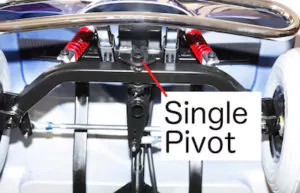
Only independent suspension on the front of a four wheeler is true suspension and gives a softer ride. Telescopic forks are the only true suspension for a three wheeler’s front wheel.
Here’s an example of strong but independent suspension on a Monarch Volta. You can see how much more work goes into designing and making this sort of suspension, which is similar to a motor car. Here the wheels will travel vertically and independently over bumps.
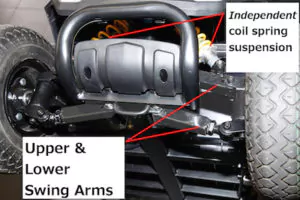
On the rear, some scooters merely have a spring on each side with no shock absorber. Again, while it is a form of suspension, it’s a bit of a cheap shortcut and is inferior to suspension with shock absorbers. Some shock absorbers are adjustable to cater for the different weights of the user. Ask your supplier to show you the actual shock absorbers inside the springs – it’s easy for you to see.
Some scooters have double springs at the rear and some have a single mono shock absorber. Both will do the job. But the real test is how much “travel” the springs have, especially on the back of the scooter – the more the spring compresses the more the shock will be absorbed.
The information presented on this page is of a general nature only and is not intended to be authoritative or exhaustive on all aspects of mobility scooter workings. If you need more information, you are advised to consult manufacturers’ web sites.

